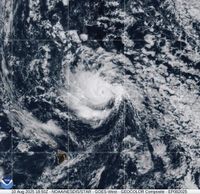On the morning of August 10, 2025, residents of Hawaii awoke to news that Tropical Storm Henriette, which had previously weakened to a tropical depression, was once again intensifying in the central Pacific. According to the National Weather Service in Honolulu, Henriette was located 415 miles north-northeast of Hilo, Hawaii, and showing signs of significant strengthening. Within hours, the Miami-based National Hurricane Center confirmed Henriette had rapidly transformed into a hurricane, with maximum sustained winds reaching 80 mph. Despite this dramatic escalation, officials made clear: the storm posed no direct threat to land.
Henriette’s journey has been a study in meteorological unpredictability. Just days earlier, the storm had lost much of its punch, only to regain strength as it moved westward into the Central Pacific. Satellite imagery from the Central Pacific Hurricane Center revealed the formation of inner-core features, and recent microwave data indicated the early stages of a broken eyewall—classic signs of a system on the verge of hurricane status. Intensity estimates ranged from 35 to 55 knots, with the initial wind speed set at 50 knots due to the latest satellite trends. "Henriette has intensified significantly overnight," the Center reported, highlighting the remarkable turnaround in the storm’s fortunes.
As Henriette tracked northwestward at about 14 to 16 knots (roughly 16 to 18 mph), a large ridge over the north-central Pacific steered its course. Model guidance suggested a straightforward path, keeping Henriette well north of the Hawaiian Islands for several days. The forecast consensus, supported by both the National Weather Service and the National Hurricane Center, was that Henriette would not make landfall or bring dangerous conditions to the islands. In fact, no coastal watches or warnings were issued at any point during the storm’s approach. The Associated Press described Henriette as a "small tropical cyclone"—a reminder that, while powerful, its reach was limited compared to some of the Pacific’s more notorious hurricanes.
Still, Henriette’s presence was felt, if only indirectly. The National Weather Service noted that the storm’s distance from Hawaii meant no direct impacts were expected, aside from subtle shifts in wind patterns and a noticeable uptick in humidity. An area of high pressure remained well to the northeast of the state, allowing Henriette to maintain its path without veering closer to the islands. As the storm passed through the region, trade winds were disrupted, leading to light and variable wind patterns through Monday afternoon. In the absence of these steady trades, island heating triggered sea breezes during the day—enhancing shower activity in leeward and interior regions—while land breezes overnight helped clear the skies and limit rainfall.
For locals and visitors alike, the most tangible effect was the weather itself. Hot and humid conditions prevailed across much of Hawaii, with dewpoint values reaching or even exceeding 70 degrees in some locations. This surge in moisture was directly linked to Henriette’s passage, as excess water vapor from the storm’s outer bands infiltrated the region. "Given the influx of excess moisture associated with Henriette while passing in the vicinity of the islands, hot and humid conditions can be expected across most locations," the National Weather Service explained. For those hoping for cool, breezy evenings, the forecast offered little relief—but at least, as officials reassured, there was no cause for alarm.
Looking ahead, meteorologists anticipated that Henriette would continue on its northwestward track, eventually moving well north of the islands late Monday into early Tuesday. As the storm’s influence waned, trade winds were expected to reestablish themselves, bringing a return to more typical Hawaiian weather patterns. The area of high pressure that had guided Henriette’s journey would once again dominate the region, albeit briefly. Forecasters also noted that, despite the storm’s current intensity, environmental factors such as increasing wind shear and cooling sea surface temperatures would likely cause Henriette to weaken and dissipate within four to five days.
Henriette’s rapid intensification was notable, especially given the marginal water temperatures in the area. Ordinarily, cooler seas would inhibit the formation and strengthening of hurricanes, but a temporary drop in wind shear and a slight uptick in sea surface temperatures provided just enough fuel for Henriette to cross the hurricane threshold. The National Hurricane Center explained, "Despite the marginal water temperatures, further strengthening is expected. Wind shear is forecast to drop to less than 10 knots by tonight, along with a small increase in SSTs and cooling upper-level temperatures." This rare confluence of factors allowed Henriette to reach hurricane status, if only briefly.
While Henriette captured most of the headlines in Hawaii, the Pacific was also home to another active system: Tropical Storm Ivo. According to the Associated Press, Ivo was located about 400 miles west of the tip of Baja California, Mexico, with maximum sustained winds of 40 mph. However, Ivo was expected to weaken to a remnant low by Monday, posing no threat to land and prompting no coastal watches or warnings. In contrast to Henriette’s dramatic rise, Ivo’s decline was steady and uneventful—a reminder that not all tropical storms follow the same script.
For residents of Hawaii—and for meteorologists tracking storms from afar—Henriette’s story is a lesson in the ever-changing nature of tropical weather. Even when a system appears to be weakening, conditions can shift rapidly, leading to unexpected intensification. Yet, as this episode demonstrates, not every hurricane spells disaster. Thanks to favorable steering currents and diligent forecasting, Henriette remained a distant spectacle, its only legacy a brief spell of muggy weather and a few anxious glances at the satellite maps.
As the Pacific hurricane season continues, eyes will remain on the open ocean, where storms like Henriette can form, strengthen, and—sometimes—fade away without ever touching land. For Hawaii, this time, fortune favored the islands, and life could go on, a little sweatier perhaps, but safely out of harm’s way.




